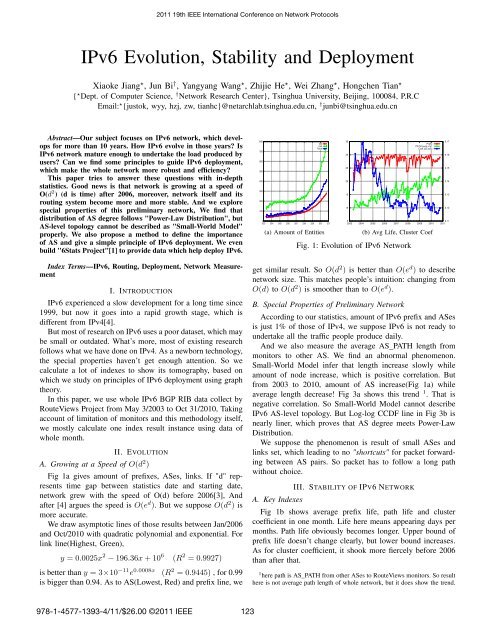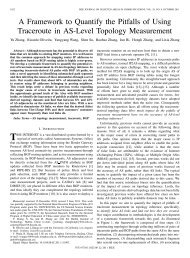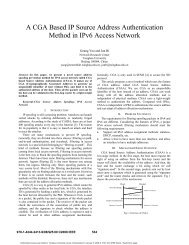IPv6 Evolution, Stability and Deployment
IPv6 Evolution, Stability and Deployment
IPv6 Evolution, Stability and Deployment
Create successful ePaper yourself
Turn your PDF publications into a flip-book with our unique Google optimized e-Paper software.
2011 19th IEEE International Conference on Network Protocols<br />
<strong>IPv6</strong> <strong>Evolution</strong>, <strong>Stability</strong> <strong>and</strong> <strong>Deployment</strong><br />
Xiaoke Jiang ⋆ , Jun Bi † , Yangyang Wang ⋆ , Zhijie He ⋆ , Wei Zhang ⋆ , Hongchen Tian ⋆<br />
{ ⋆ Dept. of Computer Science, † Network Research Center}, Tsinghua University, Beijing, 100084, P.R.C<br />
Email: ⋆ {justok, wyy, hzj, zw, tianhc}@netarchlab.tsinghua.edu.cn, † junbi@tsinghua.edu.cn<br />
Abstract—Our subject focuses on <strong>IPv6</strong> network, which develops<br />
for more than 10 years. How <strong>IPv6</strong> evolve in those years? Is<br />
<strong>IPv6</strong> network mature enough to undertake the load produced by<br />
users? Can we find some principles to guide <strong>IPv6</strong> deployment,<br />
which make the whole network more robust <strong>and</strong> efficiency?<br />
This paper tries to answer these questions with in-depth<br />
statistics. Good news is that network is growing at a speed of<br />
O(d 2 ) (d is time) after 2006, moreover, network itself <strong>and</strong> its<br />
routing system become more <strong>and</strong> more stable. And we explore<br />
special properties of this preliminary network, We find that<br />
distribution of AS degree follows "Power-Law Distribution", but<br />
AS-level topology cannot be described as "Small-World Model"<br />
properly. We also propose a method to define the importance<br />
of AS <strong>and</strong> give a simple principle of <strong>IPv6</strong> deployment. We even<br />
build "6Stats Project"[1] to provide data which help deploy <strong>IPv6</strong>.<br />
Index Terms—<strong>IPv6</strong>, Routing, <strong>Deployment</strong>, Network Measurement<br />
I. INTRODUCTION<br />
<strong>IPv6</strong> experienced a slow development for a long time since<br />
1999, but now it goes into a rapid growth stage, which is<br />
different from IPv4[4].<br />
But most of research on <strong>IPv6</strong> uses a poor dataset, which may<br />
be small or outdated. What’s more, most of existing research<br />
follows what we have done on IPv4. As a newborn technology,<br />
the special properties haven’t get enough attention. So we<br />
calculate a lot of indexes to show its tomography, based on<br />
which we study on principles of <strong>IPv6</strong> deployment using graph<br />
theory.<br />
In this paper, we use whole <strong>IPv6</strong> BGP RIB data collect by<br />
RouteViews Project from May 3/2003 to Oct 31/2010, Taking<br />
account of limitation of monitors <strong>and</strong> this methodology itself,<br />
we mostly calculate one index result instance using data of<br />
whole month.<br />
II. EVOLUTION<br />
A. Growing at a Speed of O(d 2 )<br />
Fig 1a gives amount of prefixes, ASes, links. If "d" represents<br />
time gap between statistics date <strong>and</strong> starting date,<br />
network grew with the speed of O(d) before 2006[3], And<br />
after [4] argues the speed is O(e d ). But we suppose O(d 2 ) is<br />
more accurate.<br />
We draw asymptotic lines of those results between Jan/2006<br />
<strong>and</strong> Oct/2010 with quadratic polynomial <strong>and</strong> exponential. For<br />
link line(Highest, Green),<br />
y = 0.0025x 2 − 196.36x + 10 6 (R 2 = 0.9927)<br />
is better than y = 3×10 −11 e 0.0008x (R 2 = 0.9445) , for 0.99<br />
is bigger than 0.94. As to AS(Lowest, Red) <strong>and</strong> prefix line, we<br />
8000<br />
7000<br />
6000<br />
5000<br />
4000<br />
3000<br />
2000<br />
1000<br />
AS#<br />
Link#<br />
Prefix#<br />
0<br />
2003 2004 2005 2006 2007 2008 2009 2010 2011<br />
(a) Amount of Entities<br />
35<br />
30<br />
25<br />
20<br />
15<br />
10<br />
Prefix<br />
PATH axes x1y1<br />
Coef.(y2 axis)<br />
5<br />
2003 2004 2005 2006 2007 2008 2009 2010 2011 0.11<br />
(b) Avg Life, Cluster Coef<br />
Fig. 1: <strong>Evolution</strong> of <strong>IPv6</strong> Network<br />
get similar result. So O(d 2 ) is better than O(e d ) to describe<br />
network size. This matches people’s intuition: changing from<br />
O(d) to O(d 2 ) is smoother than to O(e d ).<br />
B. Special Properties of Preliminary Network<br />
According to our statistics, amount of <strong>IPv6</strong> prefix <strong>and</strong> ASes<br />
is just 1% of those of IPv4, we suppose <strong>IPv6</strong> is not ready to<br />
undertake all the traffic people produce daily.<br />
And we also measure the average AS_PATH length from<br />
monitors to other AS. We find an abnormal phenomenon.<br />
Small-World Model infer that length increase slowly while<br />
amount of node increase, which is positive correlation. But<br />
from 2003 to 2010, amount of AS increase(Fig 1a) while<br />
average length decrease! Fig 3a shows this trend 1 . That is<br />
negative correlation. So Small-World Model cannot describe<br />
<strong>IPv6</strong> AS-level topology. But Log-log CCDF line in Fig 3b is<br />
nearly liner, which proves that AS degree meets Power-Law<br />
Distribution.<br />
We suppose the phenomenon is result of small ASes <strong>and</strong><br />
links set, which leading to no "shortcuts" for packet forwarding<br />
between AS pairs. So packet has to follow a long path<br />
without choice.<br />
A. Key Indexes<br />
III. STABILITY OF IPV6 NETWORK<br />
Fig 1b shows average prefix life, path life <strong>and</strong> cluster<br />
coefficient in one month. Life here means appearing days per<br />
months. Path life obviously becomes longer. Upper bound of<br />
prefix life doesn’t change clearly, but lower bound increases.<br />
As for cluster coefficient, it shook more fiercely before 2006<br />
than after that.<br />
1 here path is AS_PATH from other ASes to RouteViews monitors. So result<br />
here is not average path length of whole network, but it does show the trend.<br />
0.17<br />
0.16<br />
0.15<br />
0.14<br />
0.13<br />
0.12<br />
978-1-4577-1393-4/11/$26.00 ©2011 IEEE 123
1<br />
5.8<br />
5.6<br />
5.4<br />
5.2<br />
5<br />
4.8<br />
4.6<br />
4.4<br />
3.5<br />
3<br />
2.5<br />
2<br />
1.5<br />
month<br />
week<br />
day<br />
2003 2004 2005 2006 2007 2008 2009 2010 2011<br />
Fig. 2: Path# for AS Pair in one Month/Week/Day<br />
Average Length of AS PATH<br />
1<br />
0.9<br />
0.8<br />
0.7<br />
0.6<br />
1 10 100 1000<br />
1<br />
CDF<br />
Log-Log CCDF (x2-y2)<br />
0.1<br />
0.01<br />
similar index, clustering coefficient[2] (short as coef in the<br />
following), which reflects node trend of clustering, or "friends<br />
of friends".<br />
Pick 3 types of ASes first: ASes with most neighbors,<br />
biggest local coef <strong>and</strong> smallest local coef, excluding coef equal<br />
0 or 1 in order to clear effect of single link <strong>and</strong> small total joint<br />
group. Then recalculate average coef after removing AS in the<br />
picked list one by one. We find that removal of ASes with<br />
most neighbors cause greatest effect on the new average coef.<br />
This proves that kind of ASes own more important position<br />
in AS-level topology, for they contribute more to network<br />
performance.<br />
So we suppose that there does exist strategies which help to<br />
increase the robust <strong>and</strong> efficient of network when deploy <strong>IPv6</strong>.<br />
For example, connecting to AS "important" neighbors, which<br />
leads average path to other ASes short <strong>and</strong> that AS forwarding<br />
efficiency(but the whole network forwards may not be the most<br />
efficiency). And other deeply strategies can be explored.<br />
4.2<br />
4<br />
3.8<br />
2003 2004 2005 2006 2007 2008 2009 2010 2011<br />
(a) average path length<br />
0.5<br />
0.4<br />
0 100 200 300 400 500 600 700 800 900 0.001<br />
(b) AS Degree CDF <strong>and</strong> log-log CCDF<br />
Fig. 3: Special Phenomenons<br />
We also analyze appearance <strong>and</strong> disappearance of path, links<br />
<strong>and</strong> AS, prefix length <strong>and</strong> origin AS of prefix, all indexes show<br />
trend of becoming stable. In particular, status after 2006 is<br />
more stable than before that, Fig 3a is an evidence.<br />
B. Instability of Routing System<br />
There are 3 lines in Fig 2, which represent average amount<br />
of paths for AS pairs(Source AS <strong>and</strong> destination AS) calculated<br />
in different intervals: Month, Week <strong>and</strong> Day. The value<br />
decreases over time, especially the month line, decreasing from<br />
3 in 2003 to 1.5 in 2010.<br />
We also explore the similarities of set of AS, path <strong>and</strong> links<br />
between sequential months, <strong>and</strong> the similarities increase over<br />
time. All those prove that network itself <strong>and</strong> its routing system<br />
are becoming stable. And year 2006 is prove to be milestone<br />
of stability, too.<br />
A. Environment Faced<br />
IV. DISCUSSION OF DEPLOYMENT<br />
Fig 3b is AS degree CDF <strong>and</strong> log-log CCDF graph 2 , which<br />
shows the environment ISP facing to deploy <strong>IPv6</strong>. 44% of<br />
ASes only have one degree. CDF grows very fast at start-up,<br />
more than 80% of ASes have degree small than 6. It grows<br />
very slow at later stage, less than 8% of ASes have degree<br />
more than 16, but maximal degree is more than 800.<br />
B. Importance of AS<br />
We suppose that the best way to measure importance of<br />
AS is its impact to the average shortest path length, but this<br />
is really hard under the circumstance of complicated BGP<br />
configuration <strong>and</strong> business relationship. So we pick another<br />
2 Based on data in Mar/2010, others show similar properties<br />
V. CONCLUSIONS<br />
In this paper, our conclusions include:<br />
• Scale of <strong>IPv6</strong>, growing at a speed of O(d 2 ), not O(e d )<br />
as some paper argues. Growing doesn’t follow Moore’s Law,<br />
but does go into rapid spread stage.<br />
• <strong>IPv6</strong> network itself <strong>and</strong> its Routing System are becoming<br />
more <strong>and</strong> more stable.<br />
• Year 2006 is a milestone of network. After 2006, network<br />
is more mature <strong>and</strong> stable <strong>and</strong> develops faster. We suppose<br />
the reason is that network change gradually from a scientific<br />
research network to production network, for example, applications<br />
of CNGI-CERNET2 in China, <strong>IPv6</strong> site of Google <strong>and</strong><br />
<strong>IPv6</strong> commercial service of Comcast.<br />
• AS-level topology cannot described as Small-World<br />
method, which reflects properties of its preliminary stage.<br />
• AS with more neighbors take more importance position<br />
in the topology. Connecting with importance AS is a good<br />
strategy of establishing new link, which should get special care<br />
when nearly half of ASes access the Internet by single Link.<br />
And our future work will explore more special properties, a<br />
more accurate model to define importance of AS <strong>and</strong> give<br />
more deeply principles to guide <strong>IPv6</strong> deployment.<br />
VI. ACKNOWLEDGMENTS<br />
Supported by National Science Foundation of China under<br />
Grant 61073172. Program for New Century Excellent<br />
Talents in University. Specialized Research Fund for the<br />
Doctoral Program of Higher Education of China under Grant<br />
200800030034,<br />
REFERENCES<br />
[1] 6Stats Project. http://202.112.49.243/Web6/index/.<br />
[2] Cluster Coefficient. http://en.wikipedia.org/wiki/Clustering_coefficient.<br />
[3] W. Eddy. Basic properties of the ipv6 as-level topology. ACM SIGMET-<br />
RICS Performance Evaluation Review, 36(3):50–57, 2008.<br />
[4] G. Zhang, B. Quoitin, <strong>and</strong> S. Zhou. Phase changes in the evolution of<br />
the ipv4 <strong>and</strong> ipv6 as-level internet topologies. Computer Comunications<br />
(COMCOM), 34(5):649–657, 2011.<br />
124










